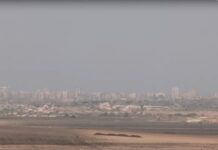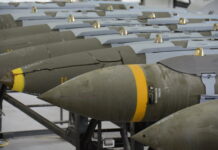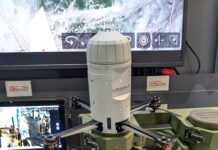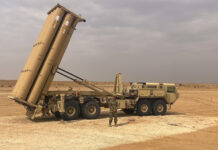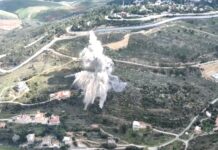Israeli rotary-wing unmanned aerial vehicle (UAV) specialist Steadicopter, working in collaboration with Israel’s Rafael, unveiled its Golden Eagle Heavy Strike (HS) UAV at the 2024 Association of the US Army (AUSA) Exhibition, held in Washington, DC, from 14 to 16 October.
With a maximum take-off weight (MTOW) of 50 kg, the Golden Eagle HS can be armed with either a Rafael Spike SR or LR2 anti-armour missile, offering enhanced lethality in a small, low-signature platform. The electro-optically guided fire-and-forget Spike SR, which weighs 10 kg, offers a range of 2.5 km, while the Spike LR2, which weighs 13 kg, offers a guided mode and a range of at least 5.5 km.
With the 50 kg MTOW Golden Eagle HS, Steadicopter has focused on what it deems to be a ‘sweet spot’ in terms of rotary-wing UAV capability. It is small enough to be tactical, transportable and deployable, while being large enough to carry a substantial payload for an operationally effective amount of time.
Talking to ESD at AUSA 2024 on 16 October, Steadicopter CEO Itai Toren explained the advantages of using a helicopter-type rotary-wing UAV as opposed to a multi-copter. “Let’s take, for example, a helicopter of 50 kg versus a multicopter of 50 kg: they will both take off and land vertically and use the same amount of energy to carry these 50 kg. That’s physics, right?” he said. “But when they start flying the helicopter, which has a rotary wing, generates lift; it will be more efficient and consume about half the energy than the multicopter, which means you can carry almost twice the payload and fly the same time, or the other way around: fly with the same payload with almost twice the endurance.”
The Golden Eagle is quoted as having an endurance of up to an hour with a payload of up to 15 kg and a communication range of up to 50 km.
“Another thing that is important to understand is that the helicopter is much stronger and robust and can take off and land in much stronger wind than a multicopter,” Toren added, “and because it can fly fast, it can penetrate strong winds that a multicopter cannot.”
Toren additionally compared the capability of the Spike-armed Golden Eagle HS to a manned attack helicopter. “Let’s take, for example, an Apache,” he said. “The Apache will cost many tens of millions of dollars. It has a crew of two that are trained for a long time as pilots, and it can carry, let’s say, eight missiles. And it will be based not on the front line; it will not be able to do a fast response, immediate response, even if it’s on immediate alert. If something happened, it would take time for him to reach the hot spot. And let’s say when it gets there, it is shot down. You lose the money that it cost, the tens of millions of dollars, you lose the lives of two trained pilots, and you lose all eight missiles at once.
“Instead of that,” Toren explained, “you can have eight of these Golden Eagle Heavy Strikes, each with one missile, take off from the front line, because it can be an organic asset of the local commander. You send all eight of them to the hot spot and, even if some are shut down, let’s say three are shot down, you haven’t lost a lot of money, you haven’t lost any life, and you’ve still got five missiles on target.”
Asked how much interest Steadicopter has received in the system, Toren said, “We get calls and queries from all over the world because this is a unique solution; it’s a game changer.” He additionally noted the system’s versatility in being able to operate from confined land areas but also from a ship.
Asked by ESD how far the development of the Golden Eagle HS had progressed, Toren replied, “We have a demonstrator; it’s flying. It’s somewhere between TRL [technology readiness level] 7 to TRL 8 and, very soon, I hope this will be operational [presumably with the Israel Defense Forces].”







